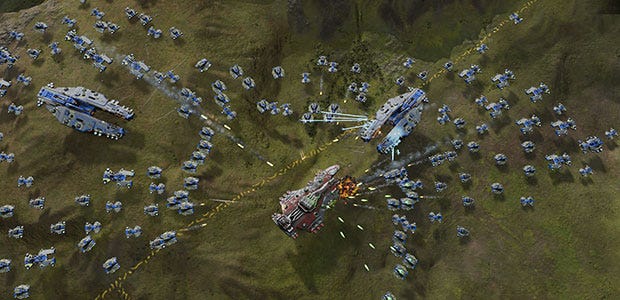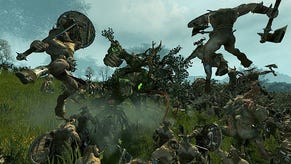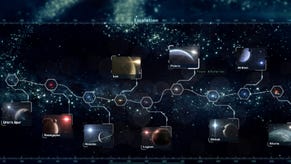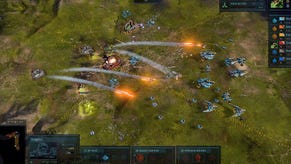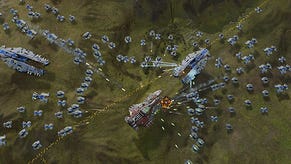Impressions: Spiritual Supreme Commander Sequel Ashes Of The Singularity
There are this many things on my screen: lots and lots and lots and lots and lots and lots and lots and lots and lots and lots and lots and lots and lots and lots and lots and lots and lots and lots and lots and lots and lots and lots and lots and lots and lots and lots and lots and lots.
And most of them are exploding.
Ashes of the Singularity [official site] isn't made by the same people as Supreme Commander (or, for that matter, its forebear Total Annihilation), but there's no denying what it's trying to be.
Massive science-fictional, real-time strategy battles, focused on armies rather than units, and with a camera which fluidly goes alllllllllll the way ouuuuuuuuuuut and allthewayin in order to demonstrate the extraordinary magnitude of these machine wars. After a few months locked into Stardock's eyewateringly expensive founders' program, a 'pre-beta' version just fetched up on Steam Early Access. As well as maybepossiblyhopefully scratching SupCom itches, it's also our first chance to take a DirectX 12 game for a spin, not to mention one which requires a quad-core processor as a minimum.
I'll get some hardware blather out the way first. I didn't notice any prettiness gains from running it in DirectX 12 mode (which requires Windows 10), but it did run a few frames faster. That said, I'm running it on an NVIDIA card, and given how much AMD has been involved in promotion for Ashes thus far, I rather suspect I'd have seen a bigger jump if I had a Radeon. Jeremy's talked about some of this stuff before, so I won't repeat it now, but for the time being my experience is that it doesn't much matter whether I run it in DX11 or 12. Apart from that the latter seems to be incompatible with everything I use to take screenshots. Bah!
Running it at 2560x1440 with most settings on high but anti-aliasing set to 2x, I was getting approximately 35 fps out of my GTX 970. It looks mostly spectacular and it's not a game that I feel would especially benefit from the magic 60, so I'm happy with that for now. The built-in benchmark tool - which I suspect will be first port of call for many early adopters - also tells me that the framerate is almost entirely handicapped by my GPU rather than CPU. That's probably to be expected given I've got a hexacore chip running at 4GHz - but then again it is half a decade old, on an equally geriatric motherboard. Running a modified test that simulates an 'infinitely powerful' GPU in order to demonstrate the capabilities of the chip, I'm getting about 75FPS.
I, uh, don't know if that helps you in any way, but basically I'm saying: I have a sort of medium-high system and I can get Ashes looking great and running pretty smooth, depending of course on how senior your rank in the framerate policeforce is. While min system requirements are higher than the norm, I don't think there's a dramatic barrier to entry.
As for the game, well, it looks the part. I ran the benchmark repeatedly, purely just to clap in delight at the vast, explodey scale of it all. It's one of those instances of a game looking like you remember an older game looking, which is perhaps because side-by-side comparisons reveal that the visual jump isn't exactly life-changingly profound. It does look better than its spiritual predecessors though: the overall impression is that the scene is richer rather than more detailed as such. It is a fine, fine sight to have on one's screen, no question about that, and does beg the question "why don't all real-time strategy games in 2015 look like this?" I should also mention that the sounds of battle are wonderful: proper speaker-shaking stuff, a true sonic warscape.
The camera doesn't go quite as far out as SupCom's, which I suspect is partly because this age of commonplace 1080p screens means it doesn't need to in order to usefully display the entire scene, and partly because Ashes had to stop short of outright copying everything. Here, you hit space to bring up the strategic map with its ant-farm swarm of dots, rather than scroll all the way out, but it's not really a hardship.
Arguably far more bothersome is this odd intangibility to the units. You know how games with PhysX effects, especially the earlier ones, seemed to scatter weightless, evaporating objects all over the place, which seemed disconnected from the game-world you were playing in? It's a little like that, these swarms of semi-ghostly tanks passing over and even through each other, with almost no apparent weight to them. It's exacerbated by the fact that everything hovers rather than rolls across the land. Not a big deal at all, but it did lend a distractingly unreal air to what's supposed to be a heavy metal war.
Ashes currently only includes multiplayer and a reasonably robust AI skirmish mode, so I can't speak to the campaign yet. There's also only one faction for now, which is the relatively vanilla Post Human Coalition. Their tanks remind me quite a bit of slightly less pointy Eldar craft from Epic 40K back in the day. The units are perhaps a little less charismatic than SupCom's, but frankly both games consciously pursue an austere aesthetic, super-units aside (and I haven't seen any of those yet, but early days). Scale is what it's about, and scale it absolutely gives. It's a real pleasure just to watch it at work.
In terms of controls and interface, it's both similar and different to SupCom. In some respects it's obvious how to play, and in others the UI is a little too busy and fiddly, but I'm not sure there are many ways around that when you've got this much information and this many controls to display.
There's more emphasis on rapid and continued acquisition of fixed resource points, displayed in a sort of nexus, than in SupCom - a little like Company of Heroes, but without the Victory Point side of things. That lends a faint skein of added artificiality to proceedings, but at the same time I can see how it's going to encourage different sort of tactics - do you hit and run the enemy or try to land-grab in order to then afford a titanic army - as well as effectively forcing you to pay attention to multiple fronts at once. Simply defending your HQ isn't enough - you need to protect your far-flung holdings too.
Then there's the Meta-Units system, which enables you to turn a group of units into effectively one, in the name of sanity - micro-managing every tank is effectively impossible, and also pointless. The Meta-Unit stuff has been a natural fit in my experience so far, which is primarily because it's not a million miles away from ye old control groups on 1,2,3,4 etc in almost any other RTS. There's more more clever AI stuff going on under the hood, and grouping tons of units into one means simply selecting the right thing(s) from the main screen is that much easier. It seems like a good addition, neither frippery or cheat.
Only longer-term play will reveal whether Ashes manages the grand tension and master-planning of SupCom: right now I'm a little distracted by what's different, and really need to get over that. But I am hugely enjoying having Ashes there on my screen, filling a nerdly need that's been left unfulfilled for half a decade. I wish it had a bit more personality, though: I think Ashes is so determined to be like SupCom and simultaneously so afraid of being identical that it hasn't quite managed to be aesthetically distinctive in its own right. But fingers crossed that wilder units and factions will show up later in development. With its single faction and handful of slightly plain maps, the current build does feel paradoxically a little small, but that's definitely going to change - and hopefully improve - before too long.
Full release is pegged for some time next year, and the good news is that Stardock claim it's already funded, with Early Access being more about testing and fine-tuning than ensuring it can be finished. #
